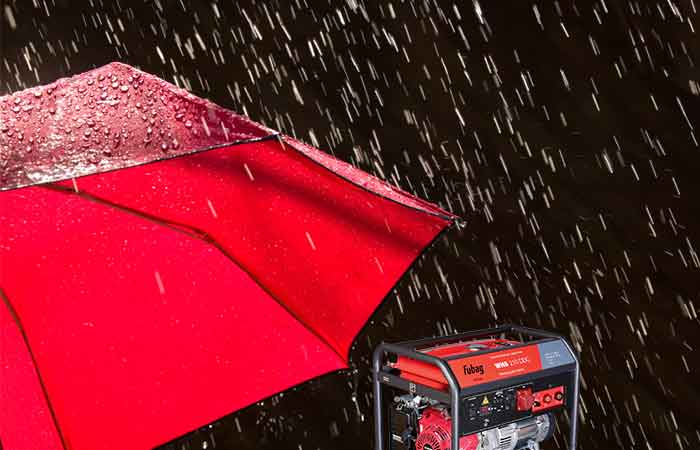Generators are a very popular option for power outage situations. They can be used to keep your home cool, refrigerator running and even your television on However, they are not always the best choice for wet conditions.
Generators can get wet if you store or run them in areas that are exposed to water. It is totally a bad idea to run a wet generator as it may result in problems some of which may be severe. You need to be careful when using generators in wet conditions be it in rain, snow, or flooding.
Here are some tips on what to do if you have a generator when it is raining, in a storm or if there is flooding in the area. In addition, find the best waterproof generator covers and how to create your own cover at home.
What happens if a generator gets wet?
When water gets to a generator, it can cause a variety of problems. The first problem that water will usually introduce is the potential for electrocution, which is very dangerous and should always be avoided at all costs.

If there’s water in your generators wiring, it won’t function properly. Electronics and water don’t play so well.
When generators get wet, they need to dry out before anyone tries to use them again or else you’ll risk getting an electric shock from touching one wire while standing on another where both have become electrified by contact with the ground (due to corrosion or other reason).
Any metal parts inside also start rusting. This could lead to grounding issues when someone touches those exposed wires when using a generator. Furthermore, generators are not designed to be used in wet conditions, so it’s always a good idea to keep them as dry as possible when in use.
If you’re transporting generators through areas where there are pools of standing or running water (such as by in boats), make sure that they don’t get too much exposure to the water because this could lead to some serious issues later on.
Generators can’t handle getting wet and will cause problems if they do. That is why generators must never come into contact with floodwaters or other kinds of liquid bodies like rainwater. You also shouldn’t use generators in the rain or when generators are in contact with other liquids like gasoline. Even when fueling, wipe off any gasoline or other fuel that finds its way to the surface of the generator.
What do I do if a generator gets wet?
In the case that your generator gets wet, you should stop using it. This includes generators that have been exposed to water, generators with wet fuel tanks, and generators in areas where there is heavy rain or flooding.
To avoid electrocution when the generator gets wet:
- Turn it off completely. Don’t just reduce the power output since that does not reduce the risk of electrocution.
- Unplug all cords from outlets before attempting any further work on the device.
- Cover all plug openings (including those for extension cords) with plastic bags or duct tape so that they are sealed off completely.
- If possible, use a dry cloth to remove excess moisture if you don’t want to unplug anything just yet.
Carry out these steps as soon as your generator becomes soaked in order to prevent electric shock while working with it. Remember this handy checklist of things not to do when dealing with a wet generator and most other wet machines.
How to safely Run Generators in Wet Weather/Conditions
There are various steps to take in order to safely use a generator in wet conditions such as the following:
- Make sure the generator has fully-functional GFCI (Ground Fault Circuit Interrupter). A GFCI helps protect against electric shock, and will beep if it senses a ground fault then turn off the generator.
- Place generators on an elevated surface (e.g., woodpile) to avoid placing them in standing water or puddles. Make sure the generator is resting firmly on all four feet before use. If generators are running in wet conditions, they can become damaged. The water will slowly seep through the components and cause rust to form on the wires. This could lead to a fire or shock hazard. To prevent this from happening make sure that your generator is elevated off of the ground at least six inches by using blocks, tables, loose stones or anything else you have available. It should also be dry underneath it when not being used because rainwater will get inside as well if there is no protection against it.
- Cover the generator with steel enclosures. Steel enclosures can be purchased at many hardware stores and home improvement chains. They are designed to prevent water from entering generators, as well as protect people that use generators in wet environments from electric shock. When you use these enclosures, make sure no metal parts on the generator are in contact with the enclosure to avoid electrocution.
- Use a plastic shed to cover the generator. Plastic sheds can also be purchased at many hardware stores and home improvement chains. Like steel enclosures, plastic sheds are also designed to prevent water from entering generators, as well as protect people that use generators in wet environments from electric shock. Make sure there is enough ventilation near the generator so it does not overheat.
- Use a generator cover to keep the generator dry during operation. Generator covers are made of waterproof material and are also designed to protect generators from the weather. They also prevent water that accumulates on generators during operation from getting inside. Make sure the cover you get is the right size and type for your type of generator to avoid damage. Unlike other option here, generator covers don’t cover the bottom of the generator hence the need to place the generator on raised ground to avoid damage by water.
- Pop-up canopies can also be used for this task although they don’t protect the generator from rains being blown sideways and will not work well with generators that are elevated.
With these options, you can be sure of protecting your generator if you decide to use it in wet conditions. Even when the generator is off, protect it with these options to avoid corrosion and other types of damage.
Best Waterproof Running/Storage Generator Covers &Tents
Following is a review of some the best tents and covers that can protect your generator from water and other harsh weather conditions. These can be used when the generator is still running outdoor or when in storage.
Champion Storm Shield Severe Weather Portable Generator Cover
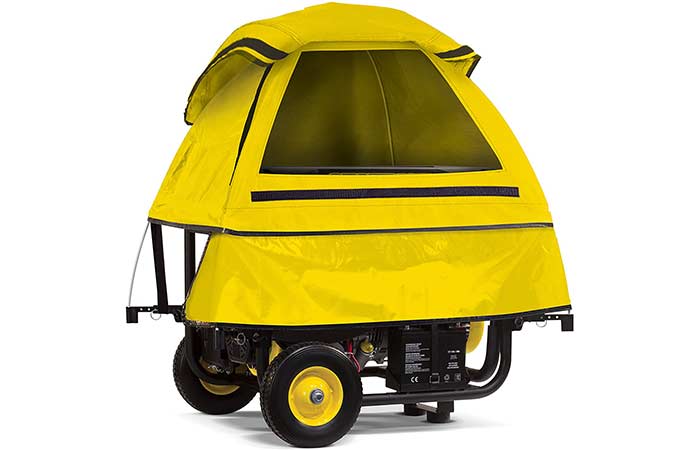
Designed by GenTent, this is one of the top selling covers on Amazon. The champion shield is easy to install, durable and reliable. Below are more features
- Installs easily in 3 simple steps with its self-attaching design-No tools needed
- For conveniency, it comes with a large refueling door and natural airflow design to allow for generator operation and maintenance while the cover is on
- The waterproof cover includes high-strength frame rods designed to withstand winds up to 70 mph, snow loads up to 18 inches and rain up to 12 inches per day
- Reliable – Champion Support includes 1-year limited warranty with FREE lifetime technical support
GenTent 10k Generator Tent Running Cover
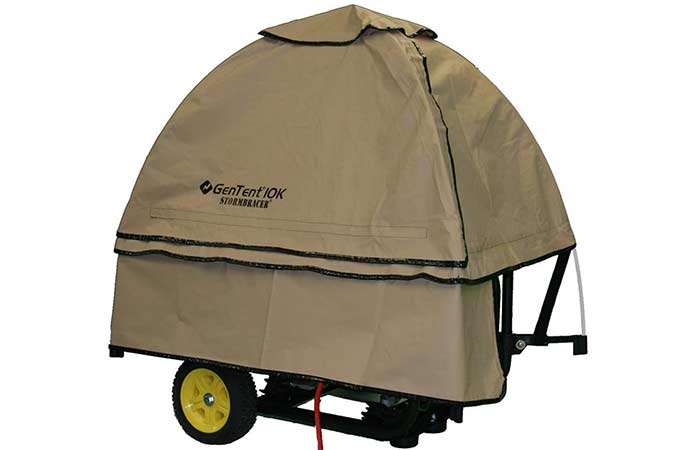
This the original design of the champion storm shield. Most features are the same, the main difference is the branding. Just like the champion version, this is easy to install, water and maintains generator natural cooling air flow.
IGAN Generator Tent Running Cover
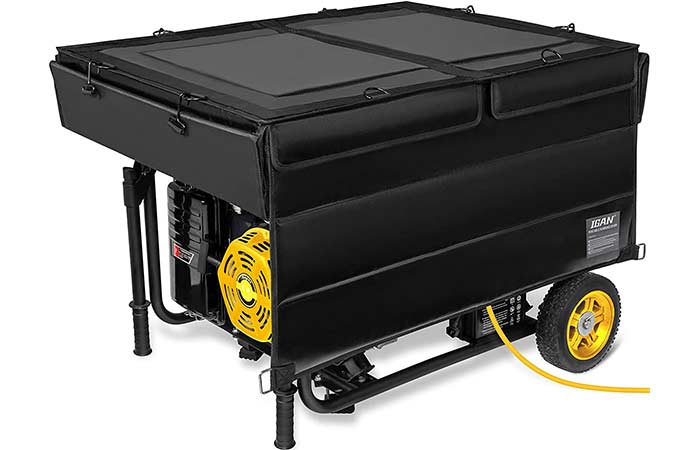
This is an ultra-cover that is designed to last while allowing you to safely whether in rain, snow, high winds or wet weather. It is easy to assemble and won’t take up too much space.
Features include;
- Ensure the sensitive sections of the machine are 100% well-protected.
- 100% waterproof tarp, weighing up to 9 pounds, can be used as storage and running cover.
- 4.High-strength Stainless Steel Frame:Each tube with a diameter of 5/8”(16mm), for tough and long lasting.
- 5.Compatible with most 3500w~12000w portable generators with tubular or square frame.
- IGAN support includes 3-year limited warranty.
Porch Shield Waterproof Universal Generator Storage Cover
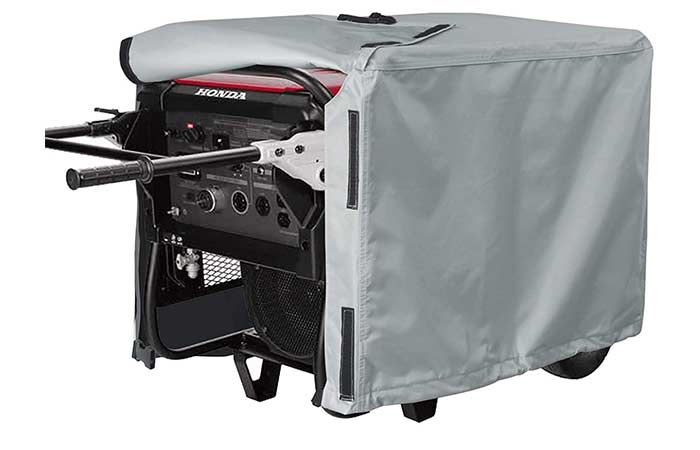
Available in 3 sizes and 3 color option, porch shield storage cover is made of 600D durable polyester fabric with an added water-resistant laminated undercoating. This cover can be a useful accessory if you want to protect your generator from rain, snow, UV rays, dust, tree sap while in storage (not running)
More feature include;
- Water-resistant backing keeps your generator completely dry. And full cover with seam sealing tape make it 100% waterproof.
- Two stacks of fabric at one side make the cover weather resistant, but ventilated. Velcro at another side allow easy install and remove.
- Elastic hem cord and bottom strap allows for a Custom secure fit, especially during high winds and severe weather.
Cover Geny Outdoor Generator Running Cover Tent
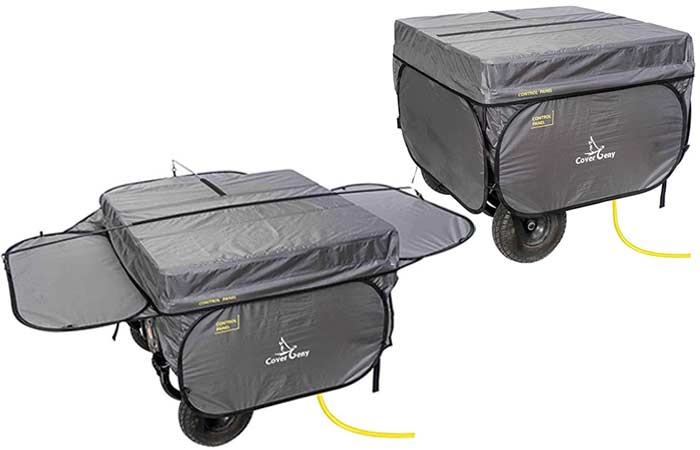
This is two-in-one waterproof cover that can be used for a running generator as well for storage. It protects your generators from all bad weathers like Rain, Snow, Ice, and Wind.
With 3 solid boards pre-install in the cover, it stays flat to water collecting on top.
Features
- Universal cover size – Fits inverter generators 4500W-12000W, no matter the generator existing frame is tubular or square.
- Made of high-density tarp material, weights up to 12 pounds. And with 4 clamp system holding the generator cover on the generator frame, the cover geny will never be blowing off by the high winds.
- Easy installation – Strap the generator frame, install the cover parts, and cover it. The portable generator cover can be a running cover when generator runs, and a storage cover when duel fuel generator stops.
How to make a DIY enclosure for a portable generator
You can make your own enclosure to keep generators dry in wet conditions. Using a tarp and some PVC pipe you can make your own enclosure for the generator that will allow air flow, but still keep it safe from rain or snow.
For this procedure, you need an aluminum sheet, a carpentry pencil, ½- and ¼-inch screws, a screwdriver, railing bars, measuring tape, louvered vents, a jigsaw, sealant caulk, and plywood.
The steps are as follows:
1. Design the type of enclosure you want
First, determine the type of enclosure you need in terms of the size, shape and direction it’ll face when in use. This will be determined by the size of the generator, the materials you have and the location of the generator while in use. Consider the ventilation and elevation from the ground to keep it safe when in use.
2. Measure and cut the top panel
Cut off the top plywood sheet, shave it down so it meets all dimensions then fix the side and front components onto its edges. Next, measure out and cut two 20.5-inch railing bars to match the height of the top paneling.
To fit the length dimensions, cut two more rails but make them a bit shorter. Next, use 1-inch-long screws to attach the railing bars to the top panel so you can align all of the other panels with it.
3. Measure and cut the front and side panels
The front panel of your generator enclosure is the piece which is located at the engine’s air intake. Apart from the back panel, the side and front panels are built in the same way since they have almost similar dimensions for most generators.
You should cut three pieces of plywood one for the front panel and the other two for the side panels. On all the pieces of plywood, measure and cut out the locations for the louvered vents to be positioned in. Fix the louvered vents into the plywood panels and secure them into place with the ½-inch screws.
4. Prepare the back panel
One of the most important steps in keeping your generator safe is maintaining its proper function. Make sure to take care of any obstructions that may prevent the exhaust from releasing properly.
Maintaining a clear pathway for fumes will help prevent damage and continued use, but remember that safety comes first. Do not compromise safety just to keep out bad weather.
The back panel ought to be about less than half the size of the front panel. The remaining sections are to be filled with aluminum flashing sheet which should be a bit larger than the wood on the back panel.
5. Fix the sheets
Once you’ve prepared the four panels for the generators, fix them using the ¼-inch screws. For protection, the aluminum sheets are clamped to the metal panel. Aluminum creates a cover for the generator and can be bent in order to release exhaust during hot weather.
6. Put the panels together
Once all the panels are prepared, it’s time to assemble them to form your generator enclosure. Fix four sheets to the railings with 1-inch screws. Align all edges as neatly as possible and use two L-brackets per corner for each panel. Fix two sheets on either side of the gate with more 1-inch screws, one at each end.
After that, seal the sealant so that it doesn’t escape out the seams. You may use a carpenter’s glue or caulk, but make sure you take into account how easily things can be adjusted later on if necessary. Once sealed, you are ready to test-fit your enclosure. Wind can cause generators to fly away, but you can prevent the enclosure from opening by wrapping bungee cords around it.
Lastly, modify the generator’s baffle box to prevent users from coming into contact with high voltage. A pallet is then added to the bottom panel to sustain the weight of the generator. As you do this, make sure you have provided for the wheels and feet of the generator.
Just like that, you’d have finished the procedure of making your own generator shed. You can then add other parts such as insulation, temperature regulator, cooling fan, fiberglass and an attic vent.
Make sure your generator cover has the following features:
- It’s waterproof to protect the generator.
- Wind-resistant to at least 72 mph of wind. This prevents wind from damaging the cover when it’s protecting the generator in a storm for example.
- Insulated against water and electric shock.
- The generator’s heating system and any other hot parts should be free to heat up and cool down without damaging the cover.
- The generator’s cooling fan should have enough space to promote circulation to keep the generator cool.
- Air vents should be open and easily accessible. They should be protected from debris and other types of damage.
- The temperature regulator and other readings should be easily accessible to have a quick glance at the state of affairs as you use the generator.
With proper planning and these tips, you can safely use your generator in wet conditions.
Safety tips when using generators
When using generators in wet conditions, there are a few additional safety tips to keep in mind:
- Do not use generators outdoors when it is raining or snowing unless it’s absolutely necessary.
- Ensure that the generator is dry and free of moisture before starting it up again.
- Keep generators away from water sources such as ponds, lakes, creeks or rivers.
- If possible, place generators on raised surfaces such as concrete slabs with gravel underneath them to prevent damage from flooding from rising groundwater levels during heavy rains in the fall season.
- Generators should never be plugged into power outlets near bodies of water because even if they don’t sink, they may still cause electrical shock hazards due to their close proximity to the water source.
- To avoid electrocution, only use one hand to touch the generator when it’s in operation.
- Make sure to use rubber gloves or other insulated materials when touching generators.
- Before adding fuel to a generator, turn it off then wait for it to cool down before you top its fuel tank. It’s also important to remember generators should never be refueled while they’re in operation. This is a major fire hazard.
- Watch children and pets carefully when generators are operating because it is possible for them to come into contact with the high voltage or get their fingers stuck in moving parts of the generator.
- Generator exhaust fumes can be hazardous, so make sure that generators are at least 25 feet away from any buildings or other structures.
- If you have a gas-powered generator, don’t use gasoline near an open flame such as a barbecue grill, stove top burner or pilot light on your furnace. This could lead to volatile explosions which can cause serious injury if not death.
- Gasoline vapors alone may produce enough heat to ignite clothing materials like wool, cotton and nylon.
- Many generators use gasoline as fuel to power their engine generators so it is important that they are stored away from living spaces in well-ventilated areas.
- If you must store generators outdoors, do not place them near windows or doors where fumes can get indoors as the generator runs.
- Mark the generator with caution signs saying “DANGER: Do not touch while operating” so bystanders know not to get near it when turned on or plugged into an outlet.
- Maintain generators regularly with oil changes and other regular maintenance procedures just like any car would require for safety reasons. For example, if generators are stored near gasoline pumps then make sure that you only run the generator far enough from the pump.
- If using generators during rain becomes necessary, be sure to cover them with tarps so that they are dry when turned off. This will prevent corrosion which could lead to power failure later.
- If running generators while flooded remember, don’t leave things plugged into outlets outside because this puts people at risk of getting electric shocks from the high voltage in the wires. Also, make sure to turn generators off if lightning starts nearby as this causes dangerous surges in electricity.
- If you have any gas-powered generators, make sure they are well ventilated by opening windows around it and keep away from combustible materials such as dry leaves or cleaning products like bleach so that there is no chance of an explosion.
- Generators should be checked every hour for moisture as they run. If generators are wet on the outside, shut them down then wipe them dry before you use them again.
- Make sure generators always have a fresh air supply by opening up windows around it when using in wet conditions. The combustion engine needs oxygen to produce power hence the need to supply fresh air to the generator at all times.
- If generators come with an extension cord, make sure you keep these cords clean as dirt can interfere with electricity flow which may cause sparks that could start fires near your generator. It is good practice to unplug anything plugged into outlets too so there are no accidental electrocutions (especially if you live in a rural area). Be wary of any overhanging trees next to generators because these can block airflow and cause generators to overheat; this could lead to a fire.
We have seen some very unfortunate incidents occur when generators were used for a long time without being properly maintained: people electrocuted because of faulty wiring, gas leaks
